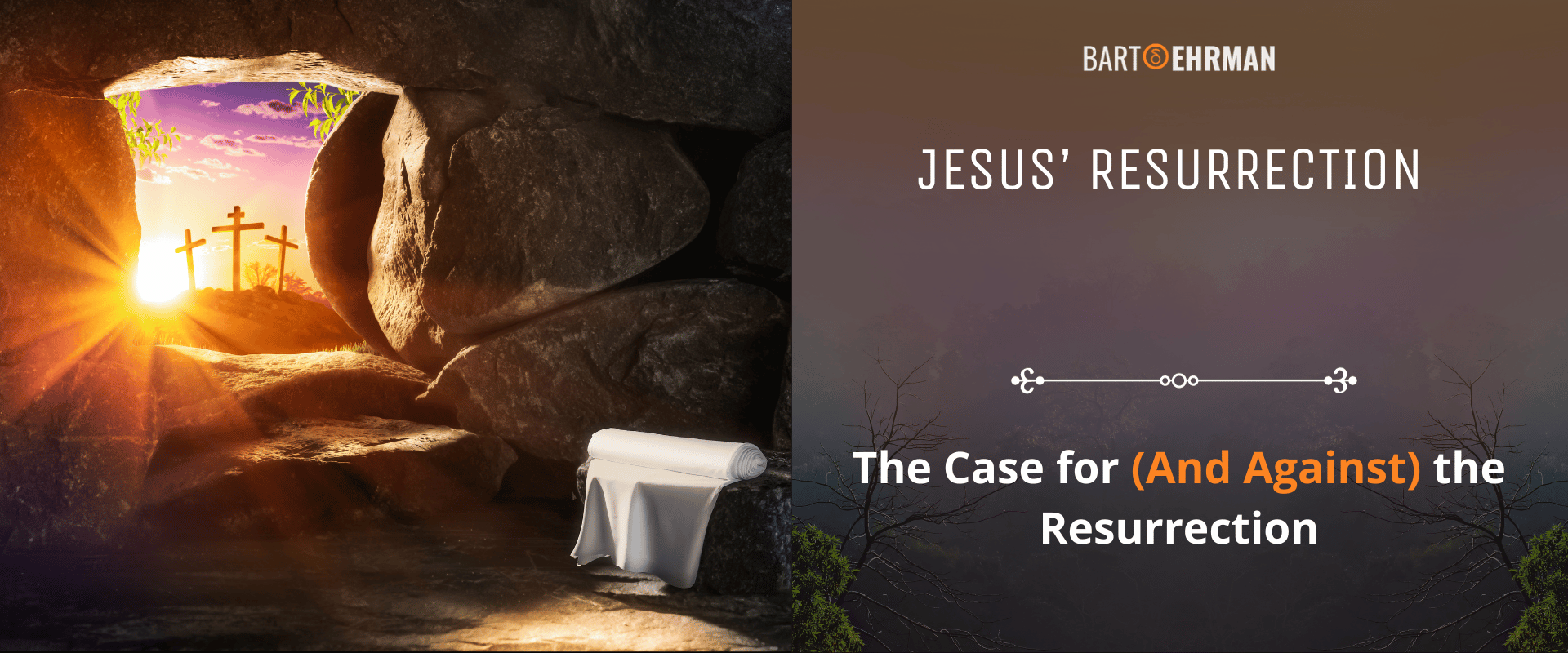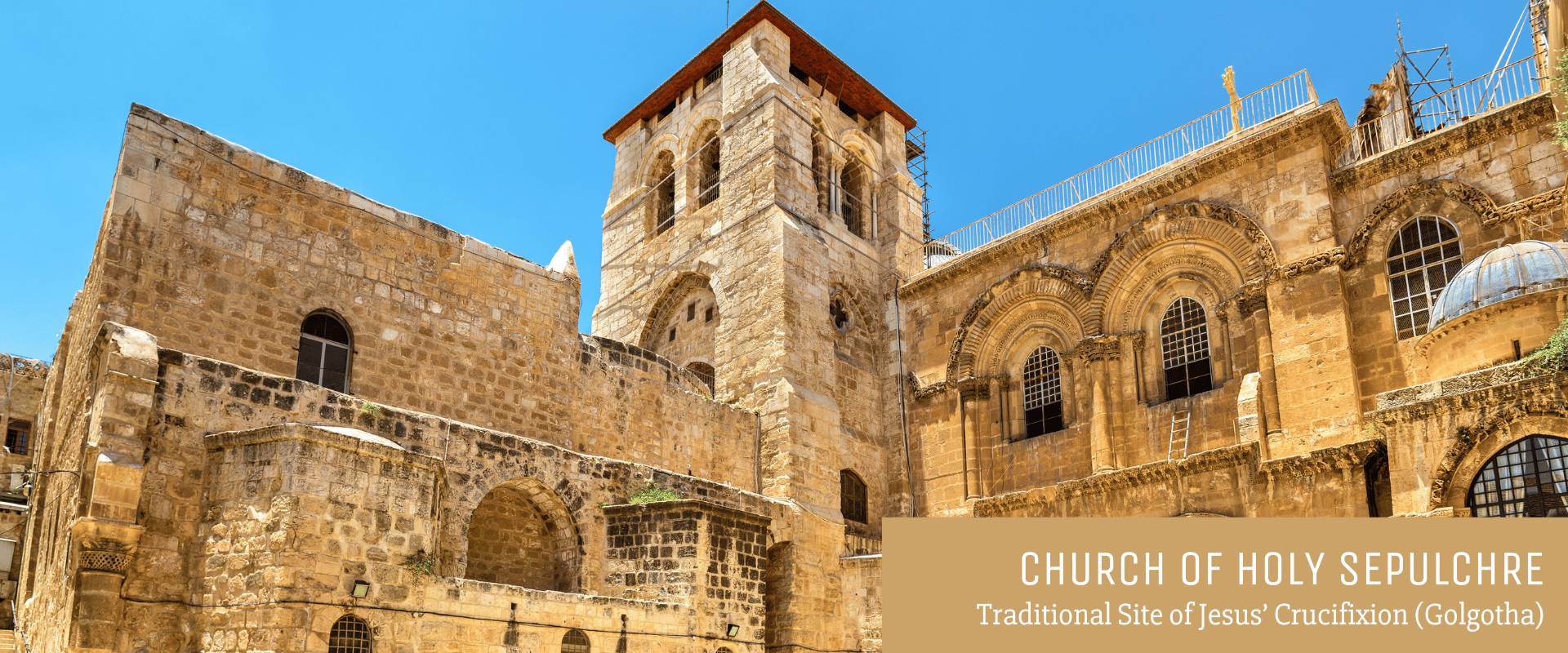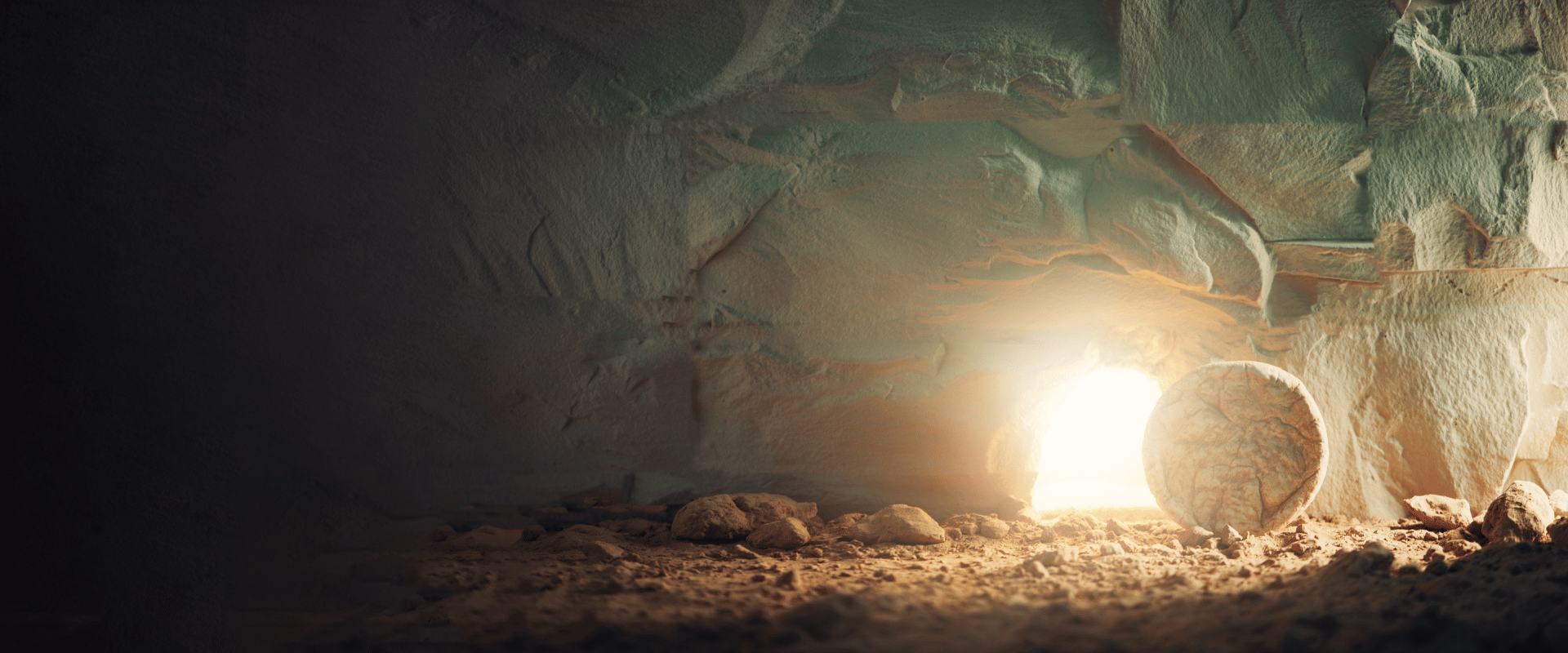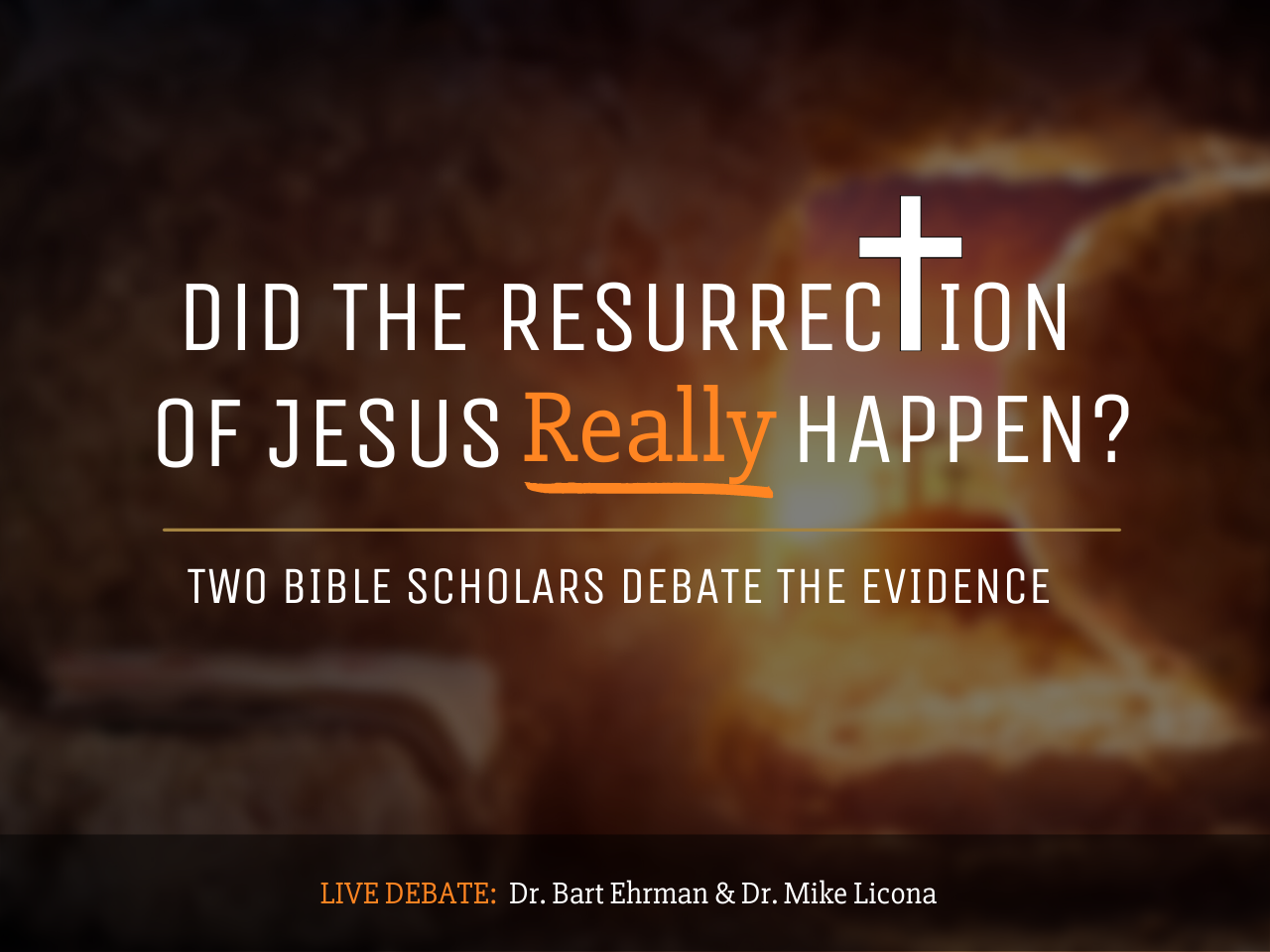Jesus’ Resurrection: The Case for (And Against) the Resurrection

Written by Marko Marina, Ph.D.
Author | Historian
Author | Historian | BE Contributor
Verified! See our guidelines
Verified! See our editorial guidelines
Date written: January 20th, 2024
Disclaimer: The views and opinions expressed in this article belong to the author and do not necessarily match my own. - Dr. Bart D. Ehrman
As a historian of early Christianity, I frequently encounter intriguing questions about Jesus and his life. Among them, two stand for the enduring curiosity and debate: “Did Jesus Exist?”, and more intriguingly, “Did Jesus’ resurrection happen?” If I had gotten a coin for each time a student asked me one of those two questions, I would be a rich man!
This article delves into the complex and often controversial topic of Jesus’ resurrection - a cornerstone event in Christian history. Our exploration isn’t rooted in theological assumptions and perspectives but grounded in historical analysis.
We aim to dissect the historical evidence of Jesus' resurrection, examining it through the lens of historical methodology and scholarly critique. This approach allows us to traverse the fine line between faith and historical evidence, providing academically rigorous and culturally significant insights.
TABLE OF CONTENTS
We begin our exploration with a narrative overview, drawing from the canonical Gospels to reconstruct the story of Jesus’ death, the discovery of the empty tomb, his post-resurrection appearances, and eventual ascension.
Following this, we’ll scrutinize the arguments often presented in support of the historicity of Jesus’ resurrection by most Christian apologists. However, our journey doesn’t end there! We’ll critically analyze these arguments thus highlighting the methodological challenges and scholarly counterpoints that question the validity of such evidence.
The historical significance of the belief in the resurrection of Jesus can’t be overstated. Beyond its theological implications, this belief was instrumental in shaping the early Christian movement and its subsequent growth into a world religion. Our discussion will shed light on this transformative power of belief as well!
Interested in delving deeper into the debate surrounding the resurrection of Jesus? Join us for an enlightening online discussion between renowned Biblical scholars Bart D. Ehrman and Mike Licona titled 'Did the Resurrection of Jesus Really Happen?' Listen to the arguments from both sides and decide for yourself!

THE RESURRECTION OF JESUS: AN OVERVIEW OF JESUS’ BETRAYAL, ARREST, TRIAL, AND CRUCIFIXION
To understand the resurrection of Jesus, we need to begin with the last days he spent in Jerusalem with his disciples. The canonical Gospels, despite their varied perspectives and questionable historical reliability, agree on several basic features of Jesus’ last days.
This pivotal sequence begins with the betrayal by one of his disciples, Judas Iscariot, setting in motion the events that would lead to Jesus' arrest and subsequent crucifixion. Judas' betrayal, often attributed to a complex mix of disillusionment and financial incentive, is a critical juncture in the narrative.
The Gospels recount how Judas, in exchange for thirty pieces of silver, agreed to lead the authorities to Jesus. This act of betrayal is poignantly symbolized at the Last Supper, where Jesus, aware of Judas' impending betrayal, shares bread with him, an act loaded with cultural and symbolic significance.
The arrest of Jesus, following Judas' guidance, occurs in the Garden of Gethsemane, a place depicted as a quiet retreat for prayer and reflection. Here, the narrative tension heightens as Jesus, aware of his impending fate, is portrayed as accepting it with a mix of solemnity and resolve.

Following the arrest, Jesus is brought before the Sanhedrin, the Jewish council, where he faces various accusations. The Gospels present this trial as fraught with legal irregularities, reflecting a broader theme of injustice and the fulfillment of a divine plan.
Despite the lack of consensus among his accusers and the seemingly reluctant Roman authority in the form of Pontius Pilate, Jesus is ultimately condemned to crucifixion, a common Roman method of execution.
>> Related: See our article, "Where Was Jesus Crucified? (And Can You Still Visit the Location)" to view images of the traditional path Jesus walked with the cross to Golgotha (Via Dolorosa) and the Church of the Holy Sepulchre (Golgotha), the traditional location of Jesus' crucifixion.
The Crucifixion itself, as described in the Gospels, is a culmination of suffering and symbolic significance. Jesus is portrayed as enduring mockery, physical abuse, and the burden of carrying his cross to Golgotha, the place of his execution. To the surprise of many, scholars are still not sure about the day, month, and year of Jesus’ death!
Daniel Marguerat notes the historical importance of Jesus’ death: “The death of Jesus gave rise to two powerful currents within Western civilization: one is Christianity, the other is anti-Semitism. Without the cross of Golgotha, the Jesus movement would not have developed into an autonomous religion. And anti-Semitism, even if it’s not a Christian invention, would never have been so virulent without the accusation against the Jews of having “killed the Lord.”
TIMELINE OF EVENTS AROUND THE RESURRECTION
Here we have provided an approximate timeline of the events leading up to the resurrection according to the Gospels, including Jesus' arrest, trial, and crucifixion.
It should be noted that some historians debate the historical accuracy of some of these events, especially the timeline around Jesus' death (See our article, "What day did Jesus die?") and Jesus' burial in Joseph of Arimathea's tomb.
We have also offered the Bible verses that support each event in the timeline.
Event | Location | Timing | Bible Verses |
|---|---|---|---|
Arrest of Jesus | Garden of Gethsemane | Night before Jesus' crucifixion | Matt. 26:47-56; Mark 14:43-52; Luke 22:47-53; John 18:2-12 |
Jesus before the Sanhedrin (Jewish trial) | High Priest's House | Night leading into the morning of the crucifixion | Matt. 26:57-68; Mark 14:53-65; Luke 22:66-71; John 18:13-27 |
Jesus before Pilate (Roman trial) | Praetorium, Jerusalem | Morning of the crucifixion | Matt. 27:11-26; Mark 15:1-15; Luke 23:1-25; John 18:28-19:16 |
Crucifixion of Jesus | Golgotha | Good Friday, Day of the crucifixion | Matt. 27:33-56; Mark 15:22-41; Luke 23:33-49; John 19:17-30 |
Jesus' Burial | Joseph of Arimathea's New Tomb | Evening of the crucifixion | Matt. 27:57-61; Mark 15:42-47; Luke 23:50-56; John 19:38-42 |
Women Visit the Tomb | Joseph of Arimathea's New Tomb | Easter Sunday, First day of the week following the crucifixion | Matt. 28:1-8; Mark 16:1-8; Luke 24:1-12; John 20:1-10 |
JESUS’ RESURRECTION Summary: FROM THE EMPTY TOMB TO THE ASCENSION
Continuing from the narration of Jesus' death, we now turn to the subsequent events as described in the Canonical Gospels, focusing on the discovery of the empty tomb, the appearance of the risen Jesus, and his ascension to heaven. These narratives are central to the Christian faith, encapsulating the essence of "the resurrection of Jesus”.
The discovery of the empty tomb, typically attributed to Mary Magdalene and other women followers of Jesus, marks the beginning of the resurrection story.
The Bible verses about the resurrection of Jesus vividly describe the early morning visit to the tomb, the encounter with an angelic being, and the initial disbelief and astonishment upon finding the tomb empty. As the author of John’s Gospel describes: “Early on the first day of the week, while it was still dark, Mary Magdalene went to the tomb and saw that the stone had been removed from the entrance (John 20:1).”
Among the various sites proposed for the location of Jesus’ tomb, the Church of the Holy Sepulchre in Jerusalem stands out as the most significant. This revered site, venerated since the 4th century and the emperor Constantine, has been a focal point of Christian pilgrimage.

What day did Jesus rise? According to the New Testament accounts Jesus rose on the third day after his crucifixion - a day that early Christians identified with the Sunday. This day is celebrated in Christianity as Easter Sunday, marking Jesus' resurrection.
The Gospels narrate various appearances of Jesus to his disciples thus reinforcing the belief in Jesus’ resurrection. These appearances, ranging from the intimate encounter with Mary Magdalene to the more public revelations to the disciples, serve multiple purposes:
Each Gospel provides its unique depiction of these appearances, contributing to a multifaceted understanding of the resurrection event. These accounts have been scrutinized and interpreted by numerous scholars and we’ll take a look at some of these issues later.
The narrative of Jesus' resurrection concludes with his ascension to heaven, an event detailed in the Gospel of Luke and the Acts of the Apostles. This moment is portrayed as the final physical departure of Jesus from Earth, occurring forty days after his resurrection.
The description of the ascension presents a dramatic and powerful image of Jesus being taken up into the clouds, leaving his disciples with a final blessing and a promise of the Holy Spirit.
EVIDENCE FOR (AND AGAINST) THE RESURRECTION
Continuing from our exploration of the accounts of the empty tomb, appearances of the risen Jesus, and his ascension, we now venture into a more investigative terrain.
While Jesus’ resurrection forms the bedrock of the Christian religion, a pivotal question arises: Is there any evidence of Jesus’ resurrection? Did it happen? Is it possible to affirm through historical analysis that Jesus conquered death?
This question opens up a complex and fascinating field of inquiry. Certain Christian apologists assert the affirmative, citing what they consider to be compelling historical evidence for Jesus' resurrection.
As we transition to this next phase of our exploration, we will delve into the common arguments and evidence presented by proponents of the historicity of Jesus' resurrection.
Jesus’ Resurrection Happened! Evidence Used by Christian Apologists
Jesus Died on the Cross
In the quest to establish the historicity of Jesus' resurrection, a fundamental premise presented by Gary Habermas and Mike Licona in their book "The Case for the Resurrection" is the assertion of Jesus' death on the cross.
This argument forms the starting point of what they term the “Minimal Facts Approach.” Habermas and Licona argue that the crucifixion of Jesus isn’t merely a theological assertion but a historical event backed by substantial evidence.
This position is also explored by Lee Strobel, who delves into the medical and forensic aspects of crucifixion. Strobel's consultation with forensic pathologist Dr. Alexander Metherell sheds light on the brutal nature of crucifixion, a method of execution that was both excruciatingly painful and demonstrably lethal.
Women as the Witnesses of the Empty Tomb
In the discourse surrounding Jesus' resurrection, a notable point raised by some Christian apologists, including scholars like N. T. Wright and William Lane Craig, is the identification of women as the primary witnesses of the empty tomb.
This aspect is consistently echoed across all four Gospels, with figures such as Mary Magdalene emerging as the first to discover the empty tomb. The use of women as central witnesses in these narratives is an interesting element, especially considering the cultural context of the time.
In the patriarchal society of the ancient world, where women’s testimonies were often viewed with skepticism and their social status was comparatively marginalized, the Gospels’ portrayal of women as the initial discoverers of the empty tomb stands out. Wright notes: “Women were simply not acceptable as legal witnesses.”
Apologists argue that the early Christians would be unlikely to invent a story with women as key witnesses if they aimed to construct a narrative that would be readily accepted and authoritative, given the societal norms of that era.
Post-Death Appearances of Jesus
A cornerstone argument often advanced by most Christian apologists revolves around the post-mortem appearances of Jesus to his disciples. Habermas and Licona, in their examination of the resurrection, assert, "There is a virtual consensus among scholars who study Jesus' resurrection that, after Jesus' death by crucifixion, his disciples believed that he appeared to them risen from the dead."
Central to this argument are the accounts documented in the earliest Christian sources, notably in the writings of the Apostle Paul. In 1 Cor 15:3-8, Paul relates a tradition that he received, believed to have originated from Jesus' closest disciples and dating back to the early years of the Jesus movement.
This passage is crucial as it lists a series of appearances of the risen Jesus, not just to Paul himself, but to all the apostles and more than five hundred other witnesses. The inclusion of a large number of witnesses, and the emphasis on the tradition being received from those who were close to Jesus, is presented as lending credence to the claim.
The argument posits that the belief in these appearances wasn’t a later development but was a foundational belief held from the earliest days of the Christian community. This point is often highlighted by apologists to argue for the historical reliability of Jesus’ resurrection.
List of Post-Resurrection Appearances (Every Appearance with Location, Timing, and Supporting Bible Verses)
Below is a timeline of the post-resurrection appearances of Jesus according to the New Testament accounts. The timeline attempts to follow the sequence of events as they are presented in the Gospels and other New Testament writings, culminating with Jesus' ascension.
We've also included the angels' appearance to the women who found the empty tomb since they were the first ones to learn about Jesus' resurrection, even if they did not technically experience a post-resurrection appearance.
Witnesses | Location | Timing | Bible Verses |
|---|---|---|---|
Women at the tomb (Angel's appearance, not Jesus') | Outside Jesus' Tomb | Easter Sunday, morning of the resurrection, the first day of the week after the Sabbath | Matthew 28:5-7; Mark 16:5-7; Luke 24:4-7 |
Mary Magdalene | Near the Tomb/Garden | Sunday, morning of the resurrection | John 20:11-18 |
Disciples on the road to Emmaus | Road to Emmaus | Afternoon of the resurrection | Luke 24:13-35 |
Simon Peter | Unknown | Afternoon/evening of the resurrection | Luke 24:34; 1 Corinthians 15:5 |
The Eleven Disciples (without Thomas) | Locked room in Jerusalem | Evening of the resurrection | Luke 24:36-43; John 20:19-23 |
The Eleven Disciples (with Thomas) | Locked room in Jerusalem | One week after the first appearance | John 20:26-29 |
The Disciples (by the Sea of Tiberias) | Sea of Tiberias/Galilee | Days/Weeks after the resurrection | John 21:1-23 |
The Eleven Disciples (mountain in Galilee) | Mountain in Galilee | Days/Weeks after the resurrection | Matthew 28:16-20 |
Over 500 brethren at once | Unknown | Days/Weeks after the resurrection | 1 Corinthians 15:6 |
James (brother of Jesus) | Unknown | Days/Weeks after the resurrection | 1 Corinthians 15:7 |
All the Apostles | Unknown | Just before the ascension | Acts 1:3-8; 1 Corinthians 15:7 |
The Disciples (Ascension of Jesus) | Mount of Olives | 40 days after the resurrection | Acts 1:9-12 |
Paul (Saul of Tarsus) | Road to Damascus | Years after the resurrection | Acts 9:3-6; 1 Corinthians 15:8 |
The Endurance of the Disciple’s Faith Amid Persecution
Among the array of arguments presented by Christian apologists to substantiate the evidence of Jesus' resurrection, the unwavering faith of Jesus' disciples, even in the face of severe persecution and martyrdom, stands out.
Sean McDowell emphasizes this aspect, stating, “The strength of their conviction, marked by their willingness to die, indicates that they did not fabricate these claims; rather, without exception, they believed Jesus to have risen from the dead."
The crux of this argument lies in the assumption that the disciples, who were direct witnesses to the events surrounding Jesus' life and post-resurrection appearances, would not willingly subject themselves to torture and martyrdom for a cause they knew to be false.
While these arguments presented by different Christian apologists offer interesting perspectives on the resurrection of Jesus, it’s essential to approach them with a critical and scholarly lens. In the following section, we’ll delve into a rigorous examination of these claims. Let’s begin!
The Historical Evidence of Jesus’ Resurrection: A Scholarly Critique
In the realm of historical scholarship, the question of "Did Jesus' resurrection happen?" poses a unique challenge, particularly when considered from the perspective of methodological limitations concerning miraculous claims.
If Jesus' resurrection occurred as a miraculous act of God, it stands beyond the scope of what historical evidence can demonstrate. Historians, limited by the empirical nature of their discipline, can’t conclusively access or evaluate divine intervention or miracles.
For instance, while historical analysis can describe events like the ancient Israelites' assault on Jericho or Jesus' crucifixion by the Romans, it can’t assert divine causality, such as God's role in bringing down Jericho's walls or the theological interpretation of Jesus' death as atonement for sins.
This methodological boundary is eloquently outlined by scholars such as John P. Meier, who notes, "It's inherently impossible for historians working with empirical evidence within the confines of their discipline ever to make a positive judgment: 'God has directly acted here to accomplish something beyond all human power.'"
Bart D. Ehrman concurs, highlighting the insurmountable challenge in demonstrating miracles historically: "Even if miracles are possible, there is no way for the historian who sticks strictly to the canons of historical evidence to show that they have ever happened."
These perspectives underscore the essential distinction between theological assertions and historical analysis. This distinction becomes even more pronounced when considering the possibility of validating miracle claims from other religious traditions with stronger historical attestations, like those of Baal Shem Tov.
To paraphrase Dale Allison's remark, once the nose of the camel of miracle is inside the tent of a historical analysis, who knows what else may enter?
In summary, while the evidence of Jesus' resurrection may be a subject of theological belief, its validation as a historical event, especially as a miraculous occurrence, remains outside the purview of historical methodology. This acknowledgment is crucial in understanding the limitations and scope of historical analysis regarding events attributed to divine intervention.
Having established the inherent limitations of historical analysis in matters of divine intervention, we now turn our attention to detailed scrutiny of the specific historical evidence of Jesus' resurrection.
For a deeper exploration into the intriguing contradictions within the New Testament accounts of Jesus’ life, I highly recommend Bart Ehrman's engaging bestseller, 'Jesus Interrupted.' Ehrman's expert analysis offers an enlightening perspective that further illuminates these complex narratives.
Examining the Historical Evidence for Jesus' Resurrection
Jesus’ Death on the Cross
In the debate surrounding the historicity of Jesus' resurrection, the argument that Jesus' death by crucifixion substantiates his subsequent resurrection always struck me as somewhat peculiar. While Christian apologists, such as Gary Habermas and Mike Licona, assert the crucifixion as one of the facts in their "Minimal Facts Approach," one can't help but wonder about the logical leap from death to resurrection.
The fact that Jesus died is indeed just that - a fact. Death, as they say, is as certain as taxes, and no one is suggesting that the latter is miraculous.
The emphasis on Jesus' death, while historically significant, doesn't inherently lead to the conclusion of his resurrection. It's a bit like saying, "I've proven my car was parked in the driveway, therefore, it must have driven itself to the store." The linkage between the two events - death and resurrection - in historical terms, seems to be a non sequitur.
One might speculate that the inclusion of Jesus' crucifixion in the resurrection argument is an attempt by apologists to create an impression of an overwhelming amount of evidence supporting the resurrection. A laundry list of 'facts' can be persuasive, but upon closer examination, some of these 'facts' appear to be more about setting the stage than delivering a compelling argument.
Women and the Empty Tomb: A Historical Analysis
In addressing the argument that women being the first witnesses to Jesus' empty tomb substantiates the resurrection, it's crucial to consider some important scholarly perspectives and inconsistencies in the Gospel narratives.
Firstly, the earliest reference to Jesus' resurrection, found in 1 Cor 15:3-8, notably omits any mention of women as witnesses to the post-resurrection appearances. This absence is intriguing, given the later Gospel accounts which prominently feature women, especially Mary Magdalene, in this role.
The discrepancy raises questions about the evolution of the resurrection narrative in the early Christian community and suggests a potential development in storytelling over time!
Furthermore, the historical authenticity of the empty tomb itself is subject to debate among scholars. John D. Crossan and Bart D. Ehrman have argued against the likelihood of Jesus receiving a proper burial, based on what is known about Roman practices at the time.
Romans typically left crucified individuals on the cross for extended periods as a form of humiliation and as a warning to others. This practice contradicts the Gospel narratives that describe a more respectful and immediate burial. Ehrman points out the absence of evidence for Roman officials granting such burials, especially for those executed for crimes against the Roman state.
While I’m not completely convinced by Ehrman's and Crossan's arguments against the traditional story of Jesus' burial, the depth and seriousness of their scholarship merit close consideration in any thorough examination of the historical events surrounding the death and resurrection of Jesus.
If you want to read more about Dr. Ehrman’s arguments against Jesus’ burial, check out this article. For a more affirmative approach check out an interview with Dr. Craig A. Evans here.
Moreover, a close, comparative reading of the Gospel accounts reveals significant differences and contradictions in their descriptions of the events following Jesus' crucifixion. These inconsistencies concern who visited the tomb, the state of the stone covering the tomb, instructions given to the women, the women's subsequent actions, and where the disciples encountered the resurrected Jesus.
Such discrepancies challenge the coherence of the resurrection narrative and suggest elements of legendary embellishments within the story. Let’s take a look at some of these discrepancies.
Who went to the tomb of Jesus?
Detail | Source |
|---|---|
Mary alone | The Gospel of John |
Mary with other women | Synoptic Gospels |
Was the stone rolled away?
Detail | Source |
|---|---|
Already rolled away | The Gospel of Mark |
Rolled after women arrived | The Gospel of Matthew |
What did the women do?
Detail | Source |
|---|---|
Said nothing about the empty tomb to anyone | The Gospel of Mark |
Told the disciples | The Gospel of Matthew |
Where did the disciples see Jesus?
Detail | Source |
|---|---|
In Galilee | The Gospel of Matthew |
In Jerusalem | The Gospel of Luke |
The Rapid Emergence of the Belief in Jesus’ Resurrection?
Apologists such as William L. Craig often assert that the belief in Jesus’ resurrection emerged too promptly to be dismissed as a mere legend or myth. They argue that myths typically require several generations to evolve and become integrated into a community’s belief system. To substantiate their claims, apologists often quote A. N. Shewin-White.
In his book Roman Society and the Roman Law in the New Testament, he noted that “even two generations are too short a span to allow the mythical tendency to prevail over the hard historic core of the tradition.”
However, in the case of Jesus’ resurrection, evidence suggests that the belief was already prevalent within a few years of his death. This is notably indicated in the tradition that the Apostle Paul reports in 1 Cor. 15:3-8 which dates back to the earliest years of the Jesus movement.
What do we make out of this argument? First, and foremost, it’s important to consider the broader historical context of myth and legend formation. The claim, often presented by apologists, rests on the assumption that several generations must pass before mythical elements can significantly influence historical narratives.
However, this assumption doesn’t necessarily hold across historical and cultural contexts.
Sherwin-White, the classical historian, did argue that several generations are needed before the mythical tendency overtakes the core historical facts, but this doesn’t imply that myth-making processes can’t begin shortly after an event.
Historical precedents demonstrate that legends and mythical attributes can indeed start forming and circulating soon after an individual's life or certain events. For example:
These examples illustrate that myths and legends don’t necessarily wait for the passage of generations. They can begin to form and spread within years, or even months, of an event or an individual's lifetime. As E. Renan astutely observed, "The greatest of errors is to suppose that legendary lore requires much time to mature; sometimes a legend is the product of a single day."
This perspective challenges the notion that the early formation of beliefs about Jesus' resurrection automatically lends them historical credibility. Instead, it suggests that these beliefs, like many others in history, could have been subject to the rapid development of legendary elements in the immediate aftermath of the events they describe.
Visions of the Resurrected Jesus: What Can Historians Know?
In examining the argument regarding the post-death appearances of Jesus, a significant aspect to consider is the nature of these appearances as described by the earliest followers. The assertion that Jesus appeared to his followers post-mortem plays a pivotal role in Christian apologetics.
However, from a historical perspective, this claim invites analysis through the lens of scholarship on visions and visionary experiences, a field that has seen considerable research over the past few decades.
Psychological studies have revealed that people can and do experience a range of visions, from sightings of deceased loved ones to encounters with religious figures and supernatural beings like angels. These experiences are often categorized into two types: veridical visions and hallucinations.
Veridical visions refer to the perception of phenomena that are actually present, a claim often made by Christians regarding Paul's vision of Jesus. On the other hand, hallucinations involve visions of phenomena that are not physically present.
To counter the claim that early followers of Jesus had hallucinations, William L. Craig notes: “It’s psychologically implausible to posit such a chain of hallucinations. Hallucinations are usually associated with mental illness or drugs, but in the disciples’ case, the prior psycho-biological preparation appears to be wanting.”
However, it's crucial to note, as Ralph W. Hood, Peter C. Hill, and Bernard Spilka assert in their textbook "Psychology of Religion: An Empirical Approach," that “there is a massive literature indicating that hallucinations are not simply characteristic of organic deficiencies.”
This suggests that experiencing hallucinations doesn’t necessarily imply a pathological state and can occur under various conditions.
The historical analysis of Paul's vision of the resurrected Jesus and other similar experiences reported by Jesus' followers thus enters a complex territory. Non-Christians might interpret these experiences as hallucinations, potentially triggered by a range of psychological or situational factors.
The most plausible historical explanation could be that several of Jesus' followers experienced some form of vision following his death.
The absence of corroborating evidence, particularly regarding the claim that 500 people witnessed the resurrected Jesus, as mentioned solely in 1 Cor 15, further complicates the narrative. It’s conceivable that these visions were interpreted and shared among early Christians, contributing to the spread of a new religious movement.
Martyrdom and Belief: The Faith in Jesus’ Resurrection
Another argument, often put forth by Christian apologists, posits that the disciples' steadfast faith, even unto death, indicates they didn’t fabricate their claims of Jesus' resurrection. However, a critical examination reveals limitations in this line of reasoning.
Firstly, the historical record of the ultimate fate of many of Jesus' disciples is far from clear. Beyond the New Testament accounts, much of what is known about figures like Thomas or Matthew is derived from later legends and hagiographical narratives.
These stories, such as Thomas' journey to India, lack the historical veracity needed to draw firm conclusions. As such, they are generally not regarded as reliable sources by critical historians. Moreover, the story of Peter’s martyrdom is a mixed bag of legends and traditions without any early authentic sources to confirm it.
Furthermore, while it’s true that some early Christian figures, such as Paul and James (the brother of Jesus), are believed to have died as martyrs, their martyrdom doesn’t necessarily validate the historical accuracy of the resurrection.
Their willingness to die for their beliefs could have been based on personal convictions rooted in visionary experiences or profound spiritual encounters. History provides numerous examples of individuals and groups who have demonstrated similar levels of commitment to their religious beliefs, often at the cost of their lives.
For instance, followers of radical interpretations of Islam have been known to undertake acts of martyrdom, convinced of the divine mandate for their sacrifice. This willingness to face death for one's beliefs, while indicative of deep conviction, doesn’t serve as conclusive proof of the objective truth of those beliefs.

The Historical Significance of Jesus’ Resurrection
Had the narrative of Jesus’ life concluded with his death, Christianity might have remained a mere footnote within Second Temple Judaism - known only to a handful of scholars. Have you heard about Judas the Galilean? You probably haven’t!
However, it was the burgeoning belief in Jesus’ resurrection that ignited the transformation of a small Jewish sect into a distinct and expansive religion - a religion with a missionary impulse that was, as Martin Goodman has shown, without a precedent.
This pivotal belief in the resurrection catalyzed the birth of Christianity, marking a defining moment in its history. Bart D. Ehrman eloquently explores the significance of this belief in his insightful book “How Jesus Became God” - it’s a must-read!
Finally, the debate over the historical evidence of Jesus' resurrection has seen an influx of new perspectives, thanks to advancements in archaeological methods, interdisciplinary approaches, and the discovery of new ancient texts.
Scholars like Dale C. Allison Jr. and Zeba Crook have brought fresh insights into early Christian texts, highlighting the diversity of beliefs about Jesus' resurrection within the early Christian community. These developments underscore the dynamic nature of historical scholarship on Jesus’ resurrection, inviting us to reconsider established narratives in light of new evidence.Jesus’ Resurrection: Summing Up Conclusions
Being a historian of early Christianity, I frequently encounter the question – not just from curious students but also from friends and family – about whether historians can prove Jesus’ resurrection.
Each time, I find myself explaining that they may be expecting too much from the discipline of history. Usually, my answer leaves them a tad disappointed; most hope for a clear-cut affirmation.
However, as I've endeavored to illustrate in this article, the reality is far from straightforward. From a historical perspective, it's beyond our capability to assert that a miracle, by its very nature, occurred. Miracles, transcending empirical evidence and scientific scrutiny, lie outside the historian's purview.
Furthermore, upon a closer examination, the common arguments put forth by various apologists, aiming to historically substantiate Jesus' resurrection, reveal significant gaps.
As historians, we are left with a conclusion that, while simple, often doesn’t satisfy: Some of Jesus' earliest followers including Paul experienced something profound that convinced them he had conquered death. What exactly did they see? Was it a veridical vision or perhaps a simple hallucination?
The answer remains elusive. And it's important to acknowledge that anyone claiming certainty on this matter, purely based on historical analysis, needs to be more truthful.
Finally, the story of the resurrection of Jesus, irrespective of its historical veracity, undeniably played a central role in the shaping of Western civilization and continues to be a subject of deep significance and enduring debate. A debate you are all welcome to join!

